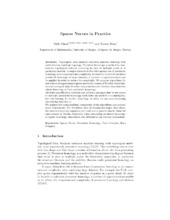Sparse Nerves in Practice
Peer reviewed, Journal article
Accepted version
Permanent lenke
https://hdl.handle.net/1956/22075Utgivelsesdato
2019Metadata
Vis full innførselSamlinger
Originalversjon
https://doi.org/10.1007/978-3-030-29726-8_17Sammendrag
Topological data analysis combines machine learning with methods from algebraic topology. Persistent homology, a method to characterize topological features occurring in data at multiple scales is of particular interest. A major obstacle to the wide-spread use of persistent homology is its computational complexity. In order to be able to calculate persistent homology of large datasets, a number of approximations can be applied in order to reduce its complexity. We propose algorithms for calculation of approximate sparse nerves for classes of Dowker dissimilarities including all finite Dowker dissimilarities and Dowker dissimilarities whose homology is Čech persistent homology. All other sparsification methods and software packages that we are aware of calculate persistent homology with either an additive or a multiplicative interleaving. In dowker_homology, we allow for any non-decreasing interleaving function α . We analyze the computational complexity of the algorithms and present some benchmarks. For Euclidean data in dimensions larger than three, the sizes of simplicial complexes we create are in general smaller than the ones created by SimBa. Especially when calculating persistent homology in higher homology dimensions, the differences can become substantial.
